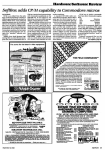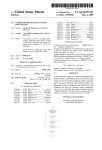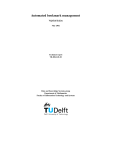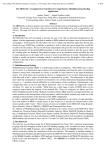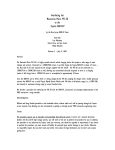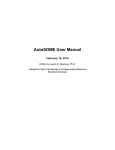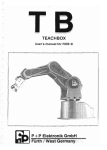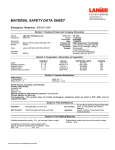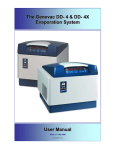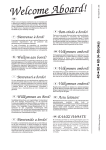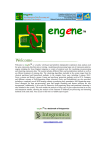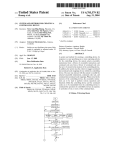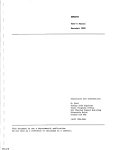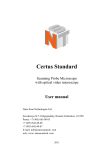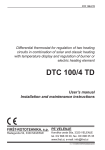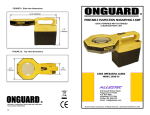Download Personal web-based teleconferencing method and system
Transcript
US 20010016038A1
(19) United States
(12) Patent Application Publication (10) Pub. No.: US 2001/0016038 A1
SAMMON et al.
(54) PERSONAL WEB-BASED
(43) Pub. Date:
Aug. 23, 2001
(21) Appl. No.:
08/806,986
(22) Filed:
Feb. 26, 1997
TELECONFERENCING METHOD AND
SYSTEM
(76) Inventors: MICHAEL J. SAMMON,
WATCHUNG, NJ (US); WAI NAM
Publication Classi?cation
TAM, FLANDERS, NJ (Us);
(51)
Int. c1.7 .................................................... .. H04M 3/42
WARREN GIFFORD, HOLMDEL, NJ
(52)
US. Cl. ...................................................... .. 379/202.01
(US); DAVID TUROCK, UPPER
MONTCLAIR, NJ (US)
Correspondence Address:
(57)
OBLON SPIVAK MCCLELLAND MAIER &
NEUSTADT PC
FOURTH FLOOR
1755 JEFFERSON DAVIS HIGHWAY
Amethod and system Which utilize a graphical user interface
ARLINGTON, VA 22202 (US)
(*)
Notice;
This is a publication of a Continued prosecution application (CPA) ?led under 37
CFR 1.53(d).
ABSTRACT
to identify potential participants in a teleconference, specify
a user-controlled dial-up/hang-up order, and monitor the
status of participants to the teleconference. The method and
system receive conference commands from a World Wide
Web
broWser and translate the conference com
mands into commands that control a telephone bridge.
IIB
Patent Application Publication Aug. 23, 2001 Sheet 1 0f 5
US 2001/0016038 A1
R6.
1
Patent Application Publication Aug. 23, 2001 Sheet 2 of 5
Name
US 2001/0016038 A1
Phone Number
Me 1 Me
2 iPersonz
3 ipersona
9085551234
isooo/min
I; 9085552345
2'; 9085553456
3$0,00/min
;$0'o0/min
i $0.00/min
E
l
: $0.00/min
$0.00/min
F“: i Z
Credit Card Information
0 AMEX
cVISA
Card No: E
Expiration:
Location:
ZipCode:
Email: E
OMasterCard
0 Discover
MWWWWM;
Month
USA
Year
Where was credit card obtained?
ZUS Credit Cards Only
F. 6
gWW
Clear lintrles E
Teleconference Control
19085551234 19085552345 19085553456
Me
PersonZ
Person3
F16, L/
Patent Application Publication Aug. 23, 2001 Sheet 3 of 5
US 2001/0016038 A1
What the phone icons mean
Line is ONHO OK
Line is DIALING
Line is OFFHOOK
‘L1G
Invalid phone number
0 outbound line
Time and Charges for Your Conference Call
N
Duration min
Dollars
19085551234
19085552345
$1.
$0.3
$5.
$0.
T
$5.
to Your Accoun
Fret. Q,
$5.
TPS Call Sciences regrets that you had trouble using our Personal Teleconferencing system. In order
for us to credit your account, please indicate the type of trouble you experienced by checking the
appropriate boxes next to each phone call. When ?nished, click the Submit button.
N
oise on the
Other
19085551234
19085552345
trouble here
{I
e trouble here
Patent Application Publication Aug. 23, 2001 Sheet 4 0f 5
US 2001/0016038 A1
‘ 1.’
‘Y
‘5
s
\x . R
D
QQ
N
\\
F4
g-
m
05
u
8
D
\I’
LL
Patent Application Publication Aug. 23, 2001 Sheet 5 0f 5
US 2001/0016038 A1
_m\F
e
3
2965 0 5 6x28m4w:
5.2m $=ozc 6519
23:52 .00531
3n2m>m #3G\\m2E1w2V
EaAEt5:
o5/.
24%”5.
85.E:
V
QM
Aug. 23, 2001
US 2001/0016038 A1
PERSONAL WEB-BASED TELECONFERENCING
METHOD AND SYSTEM
interface to identify potential participants in a teleconfer
ence, specify a user-controlled dial-up/hang-up order, and
BACKGROUND OF THE INVENTION
monitor the status of participants to the teleconference. The
method and system receive conference commands from a
World Wide Web
broWser and translate the con
ference commands into commands that control a telephone
[0001]
1. Field of the Invention
[0002]
The present invention relates to a method and
system for establishing teleconferences. More speci?cally,
the present invention relates to a neW and improved method
bridge. The best presently knoWn mode of implementing the
present invention is With a specially programmed general
purpose microprocessor programmed using microprocessor
the need for human operator support or reservations made in
advance.
speci?c executable instructions and Which communicates
With a telephone bridge. The instructions are generated by
compiling a high-level computer language program, assem
bling a loW-level computer program, and linking the tWo to
[0003] 2. Description of the Background
produce an executable program. The executable program
of establishing dial-out, multi-party teleconferences Without
[0004] KnoWn teleconference systems are generally clas
si?ed into one of tWo types of systems: 1) dial-in confer
ences and 2) dial-out or dial-up conferences; hoWever, both
types of systems are used for establishing teleconferences,
implements the method and system, and the executable
instructions are Written into a computer memory readable by
the general purpose microprocessor.
i.e., telephone communications betWeen tWo or more parties.
BRIEF DESCRIPTION OF THE DRAWINGS
Stanley et al., US. Pat. No. 4,635,251; and Frey et al., US.
Pat. No. 4,577,065; disclose dial-in conference systems.
Will become clear to those skilled in the art in vieW of the
Before a dial-in conference is established,.a reservation is
made in advance With an operator (or automated equivalent),
typically a feW days before the teleconference. The reser
vation made in advance includes the time at Which the
teleconference Will begin and the names or phone numbers
of the parties that have been invited to participate. The
operator reserves for the speci?ed time a portion of a
specialiZed telephone sWitch, called a bridge, Which Will join
or “bridge” calls from each participating caller With each of
the other callers. Examples of knoWn bridges are 1) the LNX
2000 by Excel and 2) the SDS-500 by Summa Four Inc. At
the reserved time, callers dial into a centraliZed telephone
number, typically an 800-number, and are added to the
conference, based on their calling telephone number, the
participants name, a conference identi?cation or other suit
[0007]
These and other aspects of the present invention
description of the best presently knoWn mode of carrying out
the invention and the industrial applicability of the preferred
embodiment as described herein and as illustrated in the
several ?gures of the draWings.
[0008]
FIG. 1 is a schematic illustration of a general
purpose computer for controlling a telephone bridge accord
ing to the present invention;
[0009] FIG. 2 is a partial illustration of an exemplary
computer form Which is ?lled out during conference regis
tration;
[0010] FIG. 3 is a partial illustration of an exemplary
computer form Which is ?lled out during conference regis
tration to provide billing information for a teleconference;
able identifying means. The system, hoWever, has the dis
[0011]
advantages of: 1) using reservations made in advance Which
prevent spontaneous teleconferences, and 2) not alWays
computer screen Which acts as a control interface for con
indicating Who is present on the teleconference at any given
time.
[0005]
KnoWn dial-out or dial-up conference systems,
such as those disclosed in Yunoki, US. Pat. No. 5,408,518;
and Hogan et al., US. Pat. No. 5,483,587; use reservations
made in advance and operate similarly to the dial-in con
ference. HoWever, in dial-out conferences the bridge uses
the information in the reservation made in advance to call
the participants individually. As each neW participant
accepts the invitation to join, the bridge connects the neW
participant With any other participants, thereby forming the
teleconference. Disadvantages of this type of dial-out sys
tem are that: 1) the conference initiator does not have control
FIG. 4 is a partial illustration of an exemplary
trolling the operation of a teleconference;
[0012] FIG. 5 is an illustration of exemplary computer
icons Which indicate the status of teleconference partici
pants;
[0013] FIG. 6 is a partial illustration of an exemplary
computer form Which details the charges incurred during a
teleconference Which requires a $5 .00 minimum charge;
[0014] FIG. 7 is a partial illustration of an exemplary
computer form Which alloWs problems With the teleconfer
ence to be reported during a post-teleconference “Wrap-up”;
[0015] FIG. 8 is a schematic illustration of a general
purpose computer system connected to a telephone bridge
of the order of dialing or the removal of unWanted parties,
for controlling teleconferences; and
and 2) a reservation has to be made in advance to use the
[0016] FIG. 9 is a schematic illustration of components
used to receive requests from the WWW broWser, process
the requests, send commands to the bridge and receive status
responses from the bridge.
system.
SUMMARY OF THE INVENTION
[0006] The present invention addresses the de?ciencies of
knoWn systems 1) Which do not provide user-controlled
dialing, 2) Which do not display the status of participants, 3)
Which require reservations to be made in advance, and 4)
Which require operator intervention to establish a telecon
ference. The present invention utiliZes a graphical user
DETAILED DESCRIPTION OF THE
PREFERRED EMBODIMENTS
[0017] Referring noW to the draWings, Wherein like ref
erence numerals designate identical or corresponding parts
throughout the several vieWs, FIG. 1 is a schematic illus
Aug. 23, 2001
US 2001/0016038 A1
tration of a computer system for controlling teleconferences
according to the present invention. A computer 100 imple
ments the method of the present invention, Wherein the
computer housing 102 houses a motherboard 104 Which
contains a CPU 106 and memory 108. The computer 100
also includes plural input devices, e.g., a keyboard 122 and
versal Resource Locator) Which Would identify the request
as a teleconference initiation request is:
[0020] http://WWW.tpsinc.com/ptc
[0021] Where “http” speci?es that the request should be
made using the HyperText Transfer Protocol, “WWWtpsin
mouse 124, and a display card 110 for controlling monitor
120. In addition, the computer system 100 further includes
a ?oppy disk drive 114 and other removable media devices
c.com” indicates the name of the machine on Which the
WWW server resides, and “/ptc” indicates the local resource
on the WWW server to be retrieved. It is preferable that the
WWW broWser support “forms” as de?ned by the HTML
(e.g., compact disc 119, tape, and removable magneto
2.0 standard and by the proposals for HTML 2.0+ and
optical media (not shoWn)), a hard disk 112, or other ?xed,
high density media drives, connected using an appropriate
device bus, e.g., a SCSI bus or an Enhanced IDE bus.
Although compact disc 119 is shoWn in a CD caddy, the
compact disc 119 can be inserted directly into CD-ROM
players Which do not require caddies. Also connected to the
same device bus or another device bus, the computer 100
may additionally include a compact disc reader/Writer 118 or
HTML 3.0. This alloWs information to be gathered more
compactly than can be gathered With a WWW broWser that
does not support forms. In addition, the preferred embodi
ment generates “cookies” at the WWW server When a
conference is requested and utiliZes the “cookies” as part of
the communication betWeen the WWW broWser and W
server. Other methods of saving state can also be used
depending on the capabilities of the WWW broWser that the
user is using. Hidden ?elds in forms can be used to identify
a compact disc jukebox (not shoWn). To receive control
a teleconference, or additional parameters can be used to
requests from participants, to send status information and to
establish communications With other computers, the com
create an augmented URL Which identi?es the conference.
The use of “cookies” Will be explained in more detail beloW.
puter 100 is equipped With a communications adapter (not
shoWn) Which connects directly or indirectly to the Internet,
server, the WWW broWser is sent a series of text and
[0022]
After the WWW broWser connects to the WWW
an Intranet or a Local/Wide Area NetWork. The communi
HyperText Markup Language (HTML) commands from the
cations adapter may be any one of the Wired or Wireless
communication devices that can be attached to a computer,
including, but not limited to, a modem (telephone- or
WWW server. The WWW broWser interprets the HTML
cable-based), an infra-red transceiver, an Ethernet card, a
Token-ring card, an ATM adapter, an Asymmetric Disgital
Subscriber Line, a “Fire-Wire”, or a universal serial bus. In
addition, the present invention can be implemented by a
set-top box Which provides WWW services (e.g., WebTV).
In addition, a printer (not shoWn) also provides printed lists
of teleconference information.
commands and renders the text as a screen or a form. One
such form is shoWn in FIG. 2. FIG. 2 illustrates that
multiple names and phone numbers can be entered into the
form to identify the potential participants of the teleconfer
ence. This information and the remaining information and
Web pages are transmitted betWeen the WWW server and
the WWW broWser securely to ensure that others cannot
detect credit card numbers or information about the phone
calls. Although the screen is shoWn as having slots for six
participants, more or feWer entries can be provided depend
PROMs), DRAM, SRAM, etc. Stored on any one or on a
ing upon the capabilities of the bridge or constraints estab
lished by the service provider. For users unfamiliar With the
operation of the teleconference system, help can be obtained
by clicking on the “Help” button on the form, or a demon
stration can be displayed by clicking on the “Demo” button.
Help and demonstration ?les can then be provided to the
combination of the computer readable media, the present
invention includes softWare for controlling both the hard
Ware of the computer 100 and for enabling the computer 100
user in the form of HTML documents, audio prompts or
even MPEG videos. In addition to dynamic demonstrations,
static tutorial text and images can be sent to the broWser for
[0018] The system further comprises at least one computer
readable media. Examples of such computer readable media
are compact discs, hard disks, ?oppy disks, tape, magneto
optical disks, PROMS (EPROMS, EEPROMs, Flash
to interact With a human user. Such softWare may include,
display. Also, after numbers (and potentially names) have
but is not limited to, device drivers, operating systems and
been entered into the form, a user can select the “Rate”
button to determine the cost per minute of the teleconference
user applications, such as softWare development tools. Such
computer readable media further includes the computer
program product of the present invention for real-time
on a participant-by-participant basis. This alloWs a user to
control of teleconferences via requests received from users
When the numbers of the participants have been entered and
at remote sites.
estimate the cost of a teleconference before it is started.
the user is ready to initiate a teleconference, the user selects
the “Begin Conference” button and the information in the
[0019] To provide the teleconference service, the present
form is submitted to the WWW server.
invention utiliZes a WWW server Which “listens” for con
[0023]
nection requests on a speci?ed TCP/IP ports (e. g., port 80 for
HTTP and port 443 for HTTPS). When a user Wishes to
establish a teleconference With other potential participants,
the user connects to the WWW server using a conventional
WWW broWser, such as Netscape Navigator by Netscape
Communications or Internet Explorer by Microsoft Corpo
ration, and speci?es the URL Which identi?es the request as
a teleconference initiation request. An exemplary URL (Uni
The WWW server responds by sending to the user
a second form, such as the one shoWn in FIG. 3. The second
form is ?lled in by the user to specify a method of payment
for the teleconference. Since credit cards are the most
convenient and universally used method of electronic pay
ment, the preferred embodiment uses credit card information
to authoriZe the teleconference. Other embodiments include
other methods of electronic payment such as electronic cash
transfers With a PIN or electronic payments such as those
Aug. 23, 2001
US 2001/0016038 A1
available by systems produced by CyberCash. After the
card, or other payment information, has been entered, the
user selects the “Submit” button to send to the information
to the WWW server for authoriZation. If there are any
incorrect values in the information or there are any holds on
the credit card, the teleconference Will not be initiated and
the user is asked to re-enter the information or choose
another method of payment.
[0024] If the payment method is authoriZed, the WWW
manner similar to the manner shoWn above for calling
“Person2”. In addition, if the user Wishes to disconnect a
participant from the conference call, the user can select an
off-hook icon to send the WWW server a hang-up request.
The W server Will send the bridge a command to
remove the selected participant from the conference. Com
munication betWeen the WWW server and the bridge is
discussed in more detail beloW. Also, it is possible that at the
end of a conference the user Wishes to disconnect all
server pre-authoriZes a minimum charge and sends the
broWser the control interface, such as the one shoWn in FIG.
4. Initially all the telephone icons are shoWn as displayed,
using the icon Which indicates the “on-hook” status. FIG. 5
illustrates that for this interface, the on-hook icon is a
participants simultaneously. To do so, the user selects the
telephone With the telephone handset resting in the cradle.
Typically a user Will begin by connecting himself/herself to
user determines that a number entered for a participant is
incorrect. If the user selects an invalid number, the WWW
the teleconference ?rst. To do this, the user clicks or
server Will respond by sending status information and an
icon to the user to indicate that the phone number is invalid.
otherWise selects the icon With the user’s phone number. In
FIG. 4, the user has selected the icon labeled “Me” and the
bridge has called the user. HoWever, this requires that the
user not be using his phone line already to control the WWW
broWser. If the user has a dial-up connection, a second phone
line Will have to be used to receive the phone call.
[0025]
Periodically the WWW broWser sends status
requests to the WWW server to “refresh” its status infor
mation and determine if any of the participants have
changed their statuses since the last check. This periodic
refresh is performed by including in the HTML document
the “meta” command to refresh the data, along With a refresh
“End Conference” button and the WWW server receives the
request Which is translated into a bridge command to stop
the teleconference.
[0029] It is also possible that during the teleconference the
An example icon indicating an invalid phone number is
shoWn in FIG. 5. Another possible error condition that can
occur is that there are no additional outbound lines With
Which the bridge can call participants. If this happens When
a user has selected a number to be dialed, the WWW server
sends the status information and the icon for this condition
back to the WWW broWser. An exemplary icon for this
condition also is shoWn in FIG. 5.
[0030] Even With correct numbers entered for the partici
pants, it is also possible that the teleconference as initially
con?gured Will not meet the user’s needs. If the user Wants
interval. HoWever, the WWW broWser only performs the
to add a neW participant that he/she had not originally
refresh While the user is displaying the HTML page or
document With the refresh tag. If the user selects another
URL, the user loses the ability to track status information.
thought of, the user selects the “Change Participants” button.
Using a periodic check of the status, as shoWn in FIG. 4, the
In response, the WWW server Will send back (and the
WWW broWser Will re-display) the Teleconference Setup
screen complete With all the existing numbers, but the
user is shoWn that not only has the user selected the number
corresponding to the user, the user has ansWered the phone
“Begin Conference” button is replaced With a “Return to
as indicated by the “off-hook” telephone icon.
information for participants that are on-hook. The additions/
changes are submitted to the WWW server by selecting the
“Return to Conference” button, and the Teleconference
[0026] After having completed the ?rst connection from
the bridge to the user, the bridge Will play an announcement
(if possible) to the user indicating that the user is being
Conference” button. The user can then change any of the
Control screen is redisplayed based on the neW information.
invited to participate in a teleconference. If the user Wishes
to participate, the user remains on the line. Some bridges are
[0031] When a teleconference is complete, either When all
the participants have hung up or after the user selects the
not capable of playing voice announcements to participants
as they join. If the bridge is not capable of playing a voice
“End Conference” button, the user is provided a summary of
announcement to the user, the user Will simply hear silence
shoWing the charges broken doWn by participant is shoWn in
until the next participant is added.
[0027] When the user is ready to contact the next partici
pant, the user selects the icon corresponding to the next
FIG. 6. In FIG. 6, the system is assumed to have a $5.00
minimum charge, so the $1.30 total cost is actually rounded
up to $5.00.
participant to be contacted. By selecting the icon, a request
[0032] During the post-teleconference Wrap-up, it is also
possible to report problems With the teleconference. FIG. 7
shoWs an exemplary form for reporting problems back to the
WWW server and receiving automatic credits. TWo prob
to dial the next participant is sent from the WWW broWser
to the WWW server. In FIG. 4, the user has selected
“Person2” as the next participant to be added, and the user’s
request is acknowledged by providing a response to the
HTML request Which includes an indication that the icon of
“Person2” should be displayed as a hand dialing the phone.
When “Person2” ansWers the phone, the bridge connects
“Person2” With any other participants—in this case the user.
The next time the WWW broWser refreshes its status infor
mation, the user Will be sent information indicating that
the charges that have been incurred. An exemplary form
lems that are displayed on the form are: 1) Noise on the line,
and 2) Disconnected. The user may indicate that either or
both of the conditions occurred by selecting their corre
sponding check-boxes. If either of the conditions occur, the
user is given a credit to alloW the user to reconnect Without
updated so that “Person2” also has the off-hook icon.
paying for the lost time. To avoid fraud, credits are not
provided for more than one minute per leg of any particular
call. Calls that continue longer than one minute clearly have
provided value to the user. If the line had been truly
[0028] Additional participants that Were set-up during the
unusable, the user could have just selected hang-up and
call initiation phase and that have icons can be called in a
restarted.
“Person2” has gone off-hook, and the display Will be
Aug. 23, 2001
US 2001/0016038 A1
[0033]
While a conference is proceeding, it is possible to
exceed the pre-authoriZed amount originally authorized by
the WWW server When the teleconference Was established.
Four alternate embodiments of the present invention provide
alternate responses to What happens When the pre-authoriZed
limit is exceeded. In the ?rst embodiment, the teleconfer
ence is simply cut-off When the pre-authoriZed limit has been
exceeded. In the second embodiment, the WWW broWser is
updated to request that the user pre-authoriZe an amount
equal to the original pre-authoriZed amount. If this autho
riZation is not given, then the teleconference is ended.
HoWever, the user may not be looking at the WWW broWser
at the time the call needs to be re-authoriZed, or the user may
or an HTTPS (secure HTTP) Daemon) running on the
computer system 100. If the request is for a static document,
the WWW server 300 provides the document to the broWser
as part of an HTML reply Without having to contact any
other processes. If the request requires control of the sWitch
or status information, the WWW server spaWns a CGI
program 310 to handle the request. As Would be appreciated
by one of ordinary skill in the art, the CGI program 310 can
be either a compiled program or an interpreted script.
Presently the best knoWn mode uses Perl scripts to imple
ment the CGI programs 310 spaWned by the WWW server
300. One advantage of Perl scripts is the ability to use
TCP/IP sockets to communicate With other processes, such
have directed his/her WWW broWser to look at something
as the Programmable SWitch Matrix (PSM) GateWay 320.
other than the status information. In either case, the user
As shoWn in FIG. 9, in one embodiment of the present
invention, depending on the type of request, the CGI pro
gram either requests status information from a storage
Would miss the opportunity to re-authoriZe. Therefore, in the
third embodiment, an announcement is played via the bridge
requesting that the user pre-authoriZe an amount equal to the
original pre-authoriZed amount. In the third embodiment, the
user can con?rm using DTMF tones. In the fourth and
preferred embodiment, the user is simply informed as part of
the initialiZation process that any additional charges Will be
automatically charged to his/her account, then the user’s
payment method is re-authoriZed each time the user exceeds
the existing pre-authoriZed amount. If the pre-authoriZation
ever fails, the conference is terminated at the end of the
pre-authoriZed amount.
[0034] To avoid having to re-authoriZe frequently, the
present invention pre-authoriZes the payment method
according to a statistical model of average conference length
and cost per minute for each participant. A typical pre
authoriZed amount for small conferences is $25, but for
international or large conferences, several hundred dollars
may be pre-authoriZed. Also, the pre-authoriZed amount may
be changed if the number of participants changes during the
teleconference, especially if an international number is
added. The conference monitor 340 Which tracks Whether a
conference soon Will exceed its pre-authoriZed amount is
discussed in greater detail With reference to FIG. 9.
[0035] In an alternate embodiment, the WWW server also
sends a running total of the teleconference back to the user
With each status “refresh” request. This alloWs a user to
better track the actual cost of a conference, especially With
more costly international calls.
[0036] To implement the present invention, as shoWn in
FIG. 8, the computer 100 is connected using communica
tions path 203 via the communications adapter to an external
netWork, preferably the Internet, but additional netWorks
such as a satellite data netWork or bulletin board service are
also possible. Communications channel 205 connects the
computer 100 and the bridge 200 to alloW the computer 100
to send commands to the bridge 200 and to receive status
requests from the bridge 200. The communication channel
205 can be either Wired (e.g., Token ring, Ethernet, ATM) or
Wireless (e.g., infra-red). Also, the bridge 200 is connected
via telephone lines 210 to the telephone netWork to connect
to the teleconference participants. In an alternate embodi
ment, the telephone lines 210 are replaced by other knoWn
communication media, either Wired or Wireless.
[0037] As shoWn in FIG. 9, When a request is received
from a broWser via a netWork (e.g., the Internet), the request
is received by a WWW server 300 (e.g., an HTTP Daemon
device 330 or issues a command to the PSM GateWay 320.
Status information requested from the storage device 330
includes both information received from the bridge 200
(e.g., information such as the status of the connection of
each participant), and information available from other
sources (e.g., Whether or not a payment method Was autho
riZed, participant name and telephone information, total cost
of a teleconference). When returning status information, the
CGI program reads the status information and formats the
requested status information as HTML. The CGI program
returns the HTML reply to the WWW server 300 Which
passes the HTML reply to the user via the external netWork.
In systems Which alloW the WWW server 300 to pass the
open socket to a child process and to close the original
socket, the reply does not actually pass through the WWW
server 300 but is passed directly from the CGI program 310
to the WWW broWser.
[0038] When the user requests that the bridge perform an
action on the teleconference (e.g., end the conference, dial a
number, disconnect a participant), the URL information is
sent from the CGI program 310 to the PSM GateWay 320
and the PSM GateWay 320 sends a command to a sWitch
controller 350 that controls the bridge 200. In a ?rst embodi
ment of the present invention, the sWitch controller 350 in
FIG. 9 is implemented on a separate SPARC computer and
executes the Programmable SWitch Matrix connected to the
PSM GateWay 320. The PSM and the sWitch controller 350
communicate across the communication medium 205 as if
the bridge 200 Were another computer on a netWork. HoW
ever, the bridge 200 can also be connected by a serial line
hung off of the computer running the sWitch controller 350
or any other of the communication adapters described
above. In a second embodiment of the present invention, the
processes 300, 310 and 350 are run on a single computer
100, and there is no need for PSM GateWay 320 because all
communication goes directly to the PSM. In a third embodi
ment of the present invention, the PSM is run on a second
computer or integrated into the bridge 200. In both embodi
ments, the bridge 200 receives commands (including status
requests) based on a bridge-speci?c command protocol.
[0039] One example of a communications message Which
is part of a communications protocol is listed beloW in Table
I. Table I shoWs the appropriate byte sequence for com
manding the bridge to perform a requested action, and Table
II shoWs the actual byte values of the command sequence.
For commands With replies, Table III shoWs the byte values
of a reply from the bridge 200. The structure of these replies
Aug. 23, 2001
US 2001/0016038 A1
have been taken from the LNX 2000 User’s Manual, Excel
perform status updates to the storage device 330 on a
Part Number 08-2003-02, incorporated herein by reference.
per-teleconference basis. The cookie also enables the CGI
The values of the replies are stored in the storage device 320
program 310 to distinguish betWeen a status request from a
?rst broWser and a status request from a second broWser.
(e.g., hard disk, ?ash memory, RAM).
TABLE I
Format of Byte Sequence
Field
Byte
Description
[0043] The cookie also alloWs separate billing records to
be maintained and checked by conference monitor 300.
Conference monitor 340“Wakes up” periodically and checks
the status of each line controlled by the bridge 200. For each
active leg, the conference monitor 340 determines the cost
incurred by the leg and a total cost for the corresponding
teleconference. From this, the conference monitor 340 cal
Frame Indicator
0
AlWays O x FE
Length (NN)
1
Length of bytes to folloW, not including
the checksum
culates Whether or not a teleconference Will soon exceed its
API Message Type
Sequence Number
2
3
Function type
To differentiate messages of the same
Data[O]
4
Data content of Message Type
pre-authoriZed limit. If so, the computer monitor 340 con
trols costs according to one of the four embodiments
described above.
. . .
Data content of Message Type
type
Data[ . . . ]
Data[n]
NN + 1 Data content of Message Type
Checksum
NN + 2 Checksum
[0040]
[0044] Obviously, numerous modi?cations and variations
of the present invention are possible in light of the above
teachings. It is therefore to be understood that, Within the
scope of the appended claims, the invention may be prac
ticed otherWise than as speci?cally described herein.
TABLE II
Command Byte Values Sent to Switch
What is claimed as neW and desired to be secured by Letters
Patent of the United States is:
1. A computer program product, comprising:
0 x FE
Frame Indicator
0 x 05
Message Length
0 x 4B
Create Conference
0 x 01
0 x 06
Seq. Number
Conference Size (=6)
0 x 01
0 x 00
0 x NN
Conference Type (1 = u-LaW, 2 = A-LaW, 3 = mixed)
Broadcast (O = disabled, 1 = enabled)
Checksum
a computer storage medium and a computer program code
mechanism embedded in the computer storage medium
for causing a computer to control a telephone bridge
linked to the computer, the computer controlling the
telephone bridge based on commands from a graphical
user interface of a non-operator, the computer program
code mechanism comprising:
[0041]
a ?rst computer code device con?gured to receive a
message from the graphical user interface of the
TABLE III
Response Byte Values From Switch
0 x FE
Frame Indicator
0 x 05
Message Length
0 x 4B
Create Conference
0
0
0
O
Seq. Number
Status (0 x 10 = ACK, anything else is error condition)
Conference ID (MSB)
Conference ID (LSB)
x
x
x
x
01
10
00
01
O x NN
Checksum
non-operator;
a second computer code device con?gured to convert
the message into a bridge command speci?c to the
telephone bridge;
a third computer code device con?gured to send the
bridge command to the telephone bridge;
a fourth computer code device con?gured to receive a
response from the telephone bridge; and
a ?fth computer code device con?gured to send the
[0042] Throughout the processing of teleconferences, the
PSM GateWay 320 has potentially managed more than one
teleconference simultaneously. In order to distinguish
betWeen teleconferences, the PSM GateWay 320 issues a
“cookie” or W broWser identi?er to each WWW
broWser When each user initiates a conference. To avoid
forgeries, this cookie is based the date and time of the
initiation, as Well as the process ID of the CGI process that
sent the initiation document. Together these parameters
create a “unique” ID that is dif?cult to guess randomly. After
the PSM GateWay 320 has sent this cookie to the WWW
broWser via the CGI program 310, the WWW broWser stores
the cookie internally and transmits the cookie back to the
response to the graphical user interface of the non
operator.
2. The computer program product as claimed in claim 1,
Wherein the ?rst computer code device comprises a sixth
computer code device con?gured to receive a user-command
as the message.
3. The computer program product as claimed in claim 1,
Wherein the ?rst computer code device comprises a sixth
computer code device con?gured to receive a status request
as the message.
4. The computer program product as claimed in claim 1,
Wherein the ?rst computer code device comprises a sixth
WWW server 300 With each neW command or status
computer code device con?gured to receive a secure HTML
request as the message.
request. In this Way, the PSM GateWay 320 can maintain a
table in the storage device 330 that maps control data
structures to cookies thereby enabling the PSM GateWay to
5. The computer program product as claimed in claim 2,
Wherein the second computer code device comprises a
seventh computer code device con?gured to establish a
Aug. 23, 2001
US 2001/0016038 A1
multiparty teleconference between plural teleconferees
of the icon and an icon identi?ed by the icon identi?er is
based on the message and Without a reservation made in
displayed by the graphical user interface as a status of a
advance.
6. The computer program product as claimed in claim 5,
Wherein the seventh computer code device comprises an
corresponding connection to one of the plural teleconferees.
17. The apparatus as claimed in claim 12, Wherein the
second transmitter comprises a cost transmitting unit con
eighth computer code device con?gured to establish the
multiparty teleconference using a connection message per
teleconferees.
7. The computer program product as claimed in claim 3,
Wherein the ?fth computer code device comprises a seventh
computer code device con?gured to transmit at least one of
conference before the multiparty teleconference is estab
lished.
18. The apparatus as claimed in claim 15, Wherein the
teleconference establishing unit further comprises a discon
necting unit con?gured to disconnect all of the plural
an icon and an icon identi?er as part of the response to the
status request such that at least one of the icon and an icon
single disconnect message.
identi?ed by the icon identi?er is displayed by the graphical
user interface as a status of a corresponding connection to
one of the plural teleconferees.
8. The computer program product as claimed in claim 3,
Wherein the ?fth computer code device comprises a seventh
computer code device con?gured to transmit a cost per
minute of a multiparty teleconference before the multiparty
teleconference is established.
9. The computer program product as claimed in claim 6,
Wherein the seventh computer code device further comprises
?gured to transmit a cost per minute of a multiparty tele
teleconferees from the multiparty teleconference based on a
19. A computer-implemented method for causing a com
puter to control a telephone bridge linked to the computer,
the computer controlling the telephone bridge based on
commands from a graphical user interface of a non-operator,
the method comprising the steps of:
receiving a message from the graphical user interface of
the non-operator;
converting the message into a bridge command speci?c to
the telephone bridge;
a ninth computer code device con?gured to disconnect all of
the plural teleconferees from the multiparty teleconference
transmitting the bridge command to the telephone bridge;
based on a single disconnect message.
receiving a response from the telephone bridge; and
10. An apparatus for controlling a telephone bridge based
on commands from a graphical user interface of a non
operator, the apparatus comprising:
a ?rst receiver for receiving a message from the graphical
user interface of the non-operator;
a converter for converting the message into the bridge
command speci?c to the telephone bridge;
a ?rst transmitter for transmitting the bridge command to
the telephone bridge;
a second receiver for receiving a response from the
telephone bridge; and
a second transmitter for transmitting the response to the
graphical user interface of the non-operator.
11. The apparatus as claimed in claim 10, Wherein the ?rst
receiver is a receiver con?gured to receive a user-command
as the message.
12. The apparatus as claimed in claim 10, Wherein the ?rst
receiver is a receiver con?gured to receive a status request
as the message.
13. The apparatus as claimed in claim 10, Wherein the ?rst
receiver is a receiver con?gured to receive a secure HTML
request as the message.
14. The apparatus as claimed in claim 11, Wherein the
converter comprises a teleconference establishing unit con
?gured to establish a multiparty teleconference betWeen
plural teleconferees Without a reservation made in advance.
15. The apparatus as claimed in claim 11, Wherein the
teleconference establishing unit comprises a connecting unit
con?gured to establish the multiparty teleconference using a
connection message per teleconferee.
16. The apparatus as claimed in claim 12, Wherein the
second transmitter comprises an icon transmitter con?gured
to transmit at least one of an icon and an icon identi?er as
part of the response to the status request such that at least one
transmitting the response to the graphical user interface of
the non-operator.
20. The method as claimed in claim 19, Wherein the ?rst
step of receiving a message comprises receiving a user
command as the message.
21. The method as claimed in claim 19, Wherein the ?rst
step of receiving a message comprises receiving a status
request as the message.
22. The method as claimed in claim 19, Wherein the ?rst
step of receiving comprises receiving a secure HTML
request as the message.
23. The method as claimed in claim 20, Wherein the
converting step comprises establishing a multiparty telecon
ference betWeen plural teleconferees based on the message
and Without a reservation made in advance.
24. The method as claimed in claim 23, Wherein the
establishing step comprises establishing the multiparty tele
conference using a connection message per teleconferee.
25. The method as claimed in claim 21, Wherein the step
of transmitting the response comprises transmitting at least
one of an icon and an icon identi?er as part of the response
to the status request such that at least one of the icon and an
icon identi?ed by the icon identi?er is displayed by the
graphical user interface as a status of a corresponding
connection to one of the plural teleconferees.
26. The method as claimed in claim 21, Wherein the step
of transmitting comprises transmitting a cost per minute of
a multiparty teleconference before the multiparty telecon
ference is established.
27. The method as claimed in claim 24, further compris
ing the step of disconnecting all plural teleconferees from
the multiparty teleconference based on a single disconnect
message.













